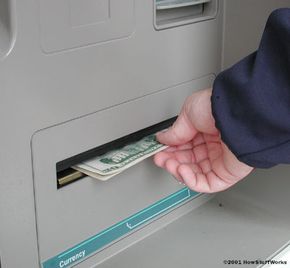Sensing Bills
The cash-dispensing mechanism has an electric eye that counts each bill as it exits the dispenser. The bill count and all of the information pertaining to a particular transaction is recorded in a journal. The journal information is printed out periodically and a hard copy is maintained by the machine owner for two years. Whenever a cardholder has a dispute about a transaction, he or she can ask for a journal printout showing the transaction, and then contact the host processor. If no one is available to provide the journal printout, the cardholder needs to notify the bank or institution that issued the card and fill out a form that will be faxed to the host processor. It is the host processor's responsibility to resolve the dispute.
Besides the electric eye that counts each bill, the cash-dispensing mechanism also has a sensor that evaluates the thickness of each bill. If two bills are stuck together, then instead of being dispensed to the cardholder they are diverted to a reject bin. The same thing happens with a bill that is excessively worn, torn, or folded.
Advertisement
The number of reject bills is also recorded so that the machine owner can be aware of the quality of bills that are being loaded into the machine. A high reject rate would indicate a problem with the bills or with the dispenser mechanism.
